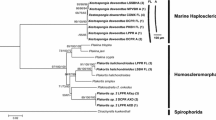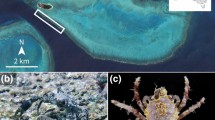Abstract
The endolithic and endopsammic habits in sponges promote similar morphologies and offer similar ecological niches of being protected and anchored. We assessed whether this also induces similar functions, i.e., whether the commonly endopsammic sponge Coelocarteria singaporensis (Carter, 1883) shares bioerosion capabilities with clionaid endopsammic sponges such as some Spheciospongia species, enabling it to inhabit and also to expand within calcareous substrates. We studied a range of traits that are commonly accepted as evidence for bioerosion. C. singaporensis has a globular or irregular body from which fistules arise, but the fistules never penetrated calcareous substrate, and while endopsammic specimens were able to agglutinate and incorporate particles, their bodies were not embedded within calcareous rock. Tough tissue filled small cavities in adjacent rock, but only in a few exceptions did we find sponge chips in it. We encountered the only indication for possible active bioerosion in the form of sponge scars and canals in some of the substrate the sponge touched or had embedded, but these areas lacked fresh erosion fissures and well-defined erosion scars and may have been made by other species. If C. singaporensis is able to bioerode, it does not seem to cut out chips to produce a regular shagreen pattern. The sponge clearly has the ability to insinuate into pre-existing cavities, but overall we regard the evidence for its bioerosion capability as circumstantial or unreliable. At this stage, we can neither confirm nor reject that this sponge may be able to bioerode calcareous material, but it appears to be unlikely.




Similar content being viewed by others
References
Annandale N (1915) Some sponges parasitic on Clionidae with further notes on that family. Rec Indian Mus 11:457–478 (pl XXXIV)
Azzini F, Calcinai B, Pansini M (2007) A new species of Coelocarteria (Porifera: Demospongiae) from Sulawesi, Indonesia. J. Mar Biol Assoc 87:1349–1353
Bavestrello G, Calcinai B, Boyer M, Cerrano C, Pansini M (2002) The aquiferous system of two Oceanapia species (Porifera, Demospongiae) studied by corrosion casts. Zoomorphology 121:195–202. https://doi.org/10.1007/s00435-002-0056-x
Becerro MA (2008) Quantitative trends in sponge ecology research. Mar Ecol 29:167–177. https://doi.org/10.1111/j.1439-0485.2008.00234.x
Bell JJ (2004) Evidence for morphology-induced sediment settlement prevention on the tubular sponge Haliclona urceolus. Mar Biol 146:29–38. https://doi.org/10.1007/s00227-004-1429-0
Bell JJ, McGrath E, Biggerstaff A, Bates T, Bennett H, Marlow J, Shaffer M (2015) Sediment impacts on marine sponges. Mar Pollut Bull 94:5–13. https://doi.org/10.1016/j.marpolbul.2015.03.030
Bergquist PR (1965) The sponges of Micronesia, part 1. The Palau Archipelago. Pac Sci 19:123–204
Bergquist PR, Fromont PJ (1988) The Marine fauna of New Zealand: Porifera, Demospongiae. Part 4, Poecilosclerida, New Zealand. Oceanogr Inst Mem 96:1–197
Bertolino M, Cerrano C, Bavestrello G, Carella M, Pansini M, Calcinai B (2013) Diversity of Porifera in the Mediterranean coralligenous accretions, with description of a new species. ZooKeys 336:1–37. https://doi.org/10.3897/zookeys.336.5139
Bertolino M, Pica D, Bavestrello G, Iwasaki N, Calcinai B (2011) A new species of Triptolemma (Porifera: Pachastrellidae) from the Pacific Ocean with a revision of the genus. J Mar Biol Assoc 91:329–338. https://doi.org/10.1017/S0025315410001530
Calcinai B, Arillo A, Cerrano C, Bavestrello G (2003) Taxonomy-related differences in the excavating micro-patterns of boring sponges. J Mar Biol Assoc 83:37–39. https://doi.org/10.1017/S0025315403006775h
Calcinai B, Bavestrello G, Cerrano C (2004) Bioerosion micro-patterns as diagnostic characteristics in boring sponges. Boll Mus Ist Biol Univ Genova 68:229–238
Calcinai B, Cerrano C, Sarà M, Bavestrello G (2000) Boring sponges (Porifera, Demospongiae) from the Indian Ocean. Ital J Zool 67:203–219. https://doi.org/10.1080/11250000009356314
Carter HJ (1883) Contributions to our knowledge of the Spongida. Ann Mag Nat Hist 5(12):308–329. https://doi.org/10.1080/00222938309459636(pls XI–XIV)
Carter HJ (1887) Report on the marine sponges, chiefly from King Island, in the Mergui Archipelago, collected for the trustees of the Indian Museum, Calcutta, by Dr. John Anderson, F.R.S., superintendent of the museum. J Linnean Soc Zool 21:61–84. https://doi.org/10.1111/j.1096-3642.1887.tb00381.x(pls 5-7)
Cerrano C, Calcinai B, Gioia di Camillo C, Valisano L, Bavestrello G (2007a) How and why do sponges incorporate foreign material? Strategies in Porifera. In: Custódio MR, Hajdu E, Lôbo-Hajdu G, Muricy G (eds) Porifera research: biodiversity, innovation and sustainability. Museu Nacional, Rio de Janeiro, pp 239–246
Cerrano C, Sambolino P, Azzini F, Calcinai B, Bavestrello G (2007b) Growth of the massive morph of Cliona nigricans (Schmidt, 1862) (Porifera, Clionaidae) on different mineral substrata. Ital J Zool 74:13–19. https://doi.org/10.1080/11250000600929370
Erwin PM, Thacker RW (2007) Incidence and identity of photosynthetic symbionts in Caribbean coral reef sponge assemblages. J Mar Biol Assoc 87:1683–1692. https://doi.org/10.1017/S0025315407058213
Fang JHK, Schönberg CHL (2015) Carbonate budgets of coral reefs: recent developments in excavating sponge research. Reef Encount 30:43–45
Fry WG, Fry PD (1979) Aspects of the functional anatomy and ecological physiology of Disyringa and some other infaunal tetractinomorph sponges. In: Lévi C, Boury-Esnault N (eds) Biologie des Spongiaires. Coll Int Centre Nat Rech Sci 291. Centre National de la Recherche Scientifique, Paris, pp 335–341
Hancock A (1849) On the excavating powers of certain sponges belonging to the genus Cliona; with descriptions of several new species, and an allied generic form. Ann Mag Nat Hist 17:321–348. https://doi.org/10.1080/03745485909494773(pls XII–XV)
Hatch WI (1980) The implication of carbonic anhydrase in the physiological mechanism of penetration of carbonate substrata by the marine burrowing sponge Cliona celata (Demospongiae). Biol Bull 159:135–147. https://doi.org/10.2307/1541014
Hooper JNA, Hall KA, Ekins M, Erpenbeck D, Wörheide G, Jolley-Rogers G (2013) Managing and sharing the escalating number of sponge “unknowns”: the SpongeMaps Project. Integr Comp Biol 53:473–481. https://doi.org/10.1093/icb/ict038
Ilan M, Abelson A (1995) The life of a sponge in a sandy lagoon. Biol Bull 189:363–369. https://doi.org/10.2307/1542154
Ise Y, Takeda M, Watanabe Y (2004) Psammobiontic Clionaidae (Demospongiae: Hadromerida) in lagoons of the Ryukyu Islands, southwestern Japan. Boll Mus Istit Biol Univ Genova 68:381–389
Kelly Borges M, Bergquist PR (1988) Sponges from Matupore Island, Papua New Guinea. Indo Malayan Zool 5:121–159
Lim SC, Tun K, Goh E (2012) Rediscovery of the Neptune’s cup sponge in Singapore: Cliona or Poterion? Contrib Mar Sci 2012:49–56
Lim SC, de Voogd NJ, Tan KS (2008) A guide to sponges of Singapore. Science Centre Singapore, Singapore
Meyer N, Wisshak M, Schönber CHL (2019) Sponge bioerosion versus aqueous pCO2: morphometric assessment of chips and etching fissures. Facies (in press)
Nardo GD (1839) Supra un nuovo genere di Spugne, le quali perforano le pietre ed i gusci marini. Ann Sci Regno Lombardo Veneto 9:221–226.
Pacheco C, Carballo JL, Cortés J, Segovia J, Trejo A (2018) Excavating sponges from the Pacific of Central America, descriptions and a faunistic record. Zootaxa 4370:451–491. https://doi.org/10.11646/zootaxa.4370.5.1
Priest BW (1881) On the natural history and histology of sponges. J Quekett Microsc Club 6:229–238 (pls XVII–XVIII)
Rützler K (1971) Bredin-Archbold-Smithsonian biological survey of Dominica: burrowing sponges, genus Siphonodictyon Bergquist, from the Caribbean. Smithsonian Contrib Zool 77:1–37
Rützler K (1997) The role of psammobiontic sponges in the reef community. Proc Eighth Int Coral Reef Symp 2:1393–1398
Rützler K, Piantoni C, van Soest RWM, Díaz MC (2014) Diversity of sponges (Porifera) from cryptic habitats on the Belize barrier reef near Carrie Bow Cay. Zootaxa 3805:1–129
Schupp P, Eder C, Paul V, Proksch P (1999) Distribution of secondary metabolites in the sponge Oceanapia sp. and its ecological implications. Mar Biol 135:573–580. https://doi.org/10.1007/s002270050658
Schönberg CHL (2000) Bioeroding sponges common to the Central Australian Great Barrier Reef: descriptions of three new species, two new records, and additions to two previously described species. Senckenbergiana Marit 30:161–221. https://doi.org/10.1007/BF03042965
Schönberg CHL (2001) Small-scale distribution of Australian bioeroding sponges in shallow water. Ophelia 55:39–54. https://doi.org/10.1080/00785236.2001.10409472
Schönberg CHL (2016a) Happy relationships between marine sponges and sediments—a review and some observations from Australia. J Mar Biol Assoc 96:493–514. https://doi.org/10.1017/S0025315415001411
Schönberg CHL (2017) Culture, demography and biogeography of sponge science: from past conferences to strategic research? Mar Ecol 38:e12416. https://doi.org/10.1111/maec.12416
Schönberg CHL, Beuck L (2007) Where Topsent went wrong: Aka infesta a.k.a. Aka labyrinthica (Demospongiae: Phloeodictyidae) and implications for other Aka spp. J Mar Biol Assoc 87:1459–1476. https://doi.org/10.1017/S0025315407058249
Schönberg CHL, Fang JKH, Carballo JL (2017a) Bioeroding sponges and the future of coral reefs. In: Bell JJ, Carballo JL (eds) Climate change, ocean acidification and sponges. Springer International, Cham, pp 179–372. https://doi.org/10.1007/978-3-319-59008-0_7
Schönberg CHL, Fang JKH, Carreiro-Silva M, Tribollet A, Wisshak M (2017b) Bioerosion: the other ocean acidification problem. ICES J Mar Sci 74:895–925. https://doi.org/10.1093/icesjms/fsw254
Schönberg CHL, Wisshak M (2012) The perks of being endolithic. Aquat Biol 17:1–5. https://doi.org/10.3354/ab00473
Schönberg CHL (2008) A history of sponge erosion: from past myths and hypotheses to recent approaches. In: Wisshak M, Tapanila L (eds) Current developments in bioerosion. Springer, Berlin, pp 165–202. https://doi.org/10.1007/978-3-540-77598-0_9
Schönberg CHL (2016b) Effects of dredging on filter feeder communities, with a focus on sponges. Final report of project 6.1 of the Dredging Science Node of the Western Australian Marine Science Institution. Perth. http://www.wamsi.org.au/sites/wamsi.org.au/files/files/Effects_of_Dredging_on_Filter_Feeders_Review_WAMSI_DSN_Report_6_1_Schönberg_2016_FINAL.pdf
Van Soest RWM, Beglinger EJ, de Voogd NJ (2010) Skeletons in confusion: a review of astrophorid sponges with (dicho-)calthrops as structural megascleres (Porifera, Demospongiae, Astrophorida). ZooKeys 68:1–88. https://doi.org/10.3897/zookeys.68.729
Van Soest RWM, Zea S, Kielman M (1994) New species of Zyzzya, Cornulella, Damiria, and Acheliderma (Porifera: Poecilosclerida), with a review of fistular genera of Iophonidae. Bijdr Dierk 64:163–192
Southwell MW, Weisz JB, Martens CS, Lindquist N (2008) In situ fluxes of dissolved inorganic nitrogen from the sponge community on Conch Reef, Key Largo, Florida. Limnol Oceanogr 53:986–996. https://doi.org/10.4319/lo.2008.53.3.0986
Topsent E (1888) Contribution à l’étude des Clionides. Arch Zool Exp Gén 2:1–165 (pls I–VII)
Van Soest RWM, Boury-Esnault N, Hooper JNA, Rützler K, de Voogd NJ, Alvarez B, Hajdu E, Pisera AB, Manconi R, Schönberg CHL, Klautau M, Picton B, Kelly M, Vacelet J, Dohrmann M, Díaz MC, Cárdenas P, Carballo JL, Ríos P, Downey R (2019) World Porifera Database. http://www.marinespecies.org/porifera/index.php. Accessed on 8 Jan 2019
Werding B, Sanchez H (1991) Life habits and functional morphology of the sediment infaunal sponges Oceanapia oleracea and Oceanapia peltata (Porifera, Haplosclerida). Zoomorphology 110:203–208. https://doi.org/10.1007/BF01633004
Wisshak M (2008) Two new dwarf Entobia ichnospecies in a diverse aphotic ichnocoenosis (Pleistocene/Rhodes, Greece). In: Wisshak M, Tapanila L (eds) Current developments in bioerosion. Springer, Berlin, pp 213–233. https://doi.org/10.1007/978-3-540-77598-0_11
Acknowledgements
The Great Barrier Reef sample was taken during fieldwork that was funded by the Australian Institute of Marine Science. Flora Siebler and Evy Büttner are acknowledged for field support. Jane Fromont, Oliver Gomez, and Andrew Hosie provided access to laboratory equipment at the Western Australian Museum. We would like to acknowledge the St. John’s Island National Marine Laboratory for providing the facility necessary for conducting the research on the Singaporean material. The Laboratory is a National Research Infrastructure under the National Research Foundation Singapore.
Author information
Authors and Affiliations
Corresponding author
Additional information
This article is part of a Topical Collection in FACIES on “Bioerosion”, guest edited by Max Wisshak et al.
Rights and permissions
About this article
Cite this article
Schönberg, C.H.L., Lim, SC. Psammobiosis and bioerosion: examining ecological strategies in sponges using the case example Coelocarteria singaporensis. Facies 65, 14 (2019). https://doi.org/10.1007/s10347-019-0556-5
Received:
Accepted:
Published:
DOI: https://doi.org/10.1007/s10347-019-0556-5




